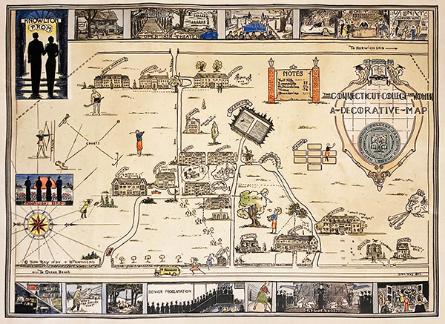Shain Library First Floor Exhibition Area
Mapping Traditions: The Camel Experience in the 1930s & 1940s
Using a 1934 map of campus as a starting point, this exhibition explores some of the traditions and common experiences popular at Connecticut College a century ago. The Connecticut College for Women: A Decorative Map was created by Barbara Townsend, class of 1934, and the unknown artist Don Ray. It is bordered by vignettes of campus life that are brought to life using items from the College Archives.

Scenes shown on the map illustrate rituals around class spirit and friendly rivalry. Sophomores initiated first years during a week of hazing activities and juniors hid a replica of their class mascot for sophomores to find. Seniors proclaimed the privileges owed them by the other classes and sang during every full moon. Setting aside rivalries, students in all classes enjoyed the Arboretum and danced in the Knowlton Salon. In addition to the traditions featured on the map, other pictures highlight different aspects of life on campus, both good and bad.
Some of these practices may seem peculiar and old-fashioned; some exhibit attitudes or activities that oppose current campus values and policies. But some are timeless. As you view the exhibition think about your own favorite campus traditions or Camel experiences. How are they similar to or different from those shown on the map?
Charles Chu Asian Art Reading Room
Watercolors from the Chu-Griffis Collection
Linda Lear Center for Special Collections and Archives
Zines, Comix, and Artists' Books
While artists' books have long been a collecting focus of the Linda Lear Center for Special Collections and Archives, other contemporary formats such as zines and underground comix have become an increasingly important resource for documenting current art and culture. This collection highlights some recent additions to the collection displaying a variety of uses and formats of this ephemera medium.